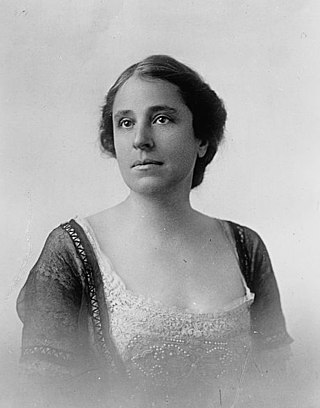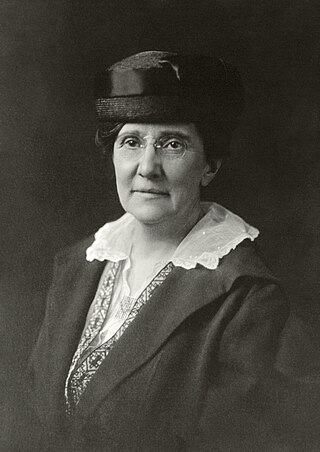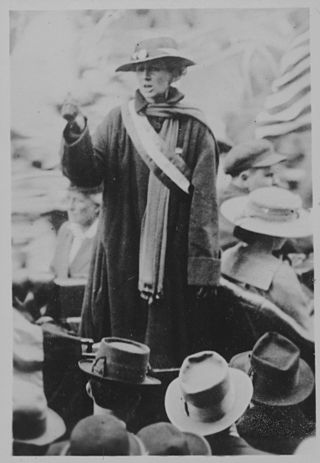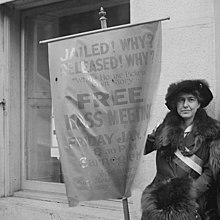
Alice Stokes Paul was an American Quaker, suffragette, suffragist, feminist, and women's rights activist, and one of the foremost leaders and strategists of the campaign for the Nineteenth Amendment to the United States Constitution, which prohibits sex discrimination in the right to vote. Paul initiated, and along with Lucy Burns and others, strategized events such as the Woman Suffrage Procession and the Silent Sentinels, which were part of the successful campaign that resulted in the amendment's passage in August 1920.

The National Woman's Party (NWP) was an American women's political organization formed in 1916 to fight for women's suffrage. After achieving this goal with the 1920 adoption of the Nineteenth Amendment to the United States Constitution, the NWP advocated for other issues including the Equal Rights Amendment. The most prominent leader of the National Woman's Party was Alice Paul, and its most notable event was the 1917–1919 Silent Sentinels vigil outside the gates of the White House.

The Silent Sentinels, also known as the Sentinels of Liberty, were a group of over 2,000 women in favor of women's suffrage organized by Alice Paul and the National Woman's Party, who nonviolently protested in front of the White House during Woodrow Wilson's presidency starting on January 10, 1917. Nearly 500 were arrested, and 168 served jail time. They were the first group to picket the White House. Later, they also protested in Lafayette Square, not stopping until June 4, 1919 when the Nineteenth Amendment to the United States Constitution was passed both by the House of Representatives and the Senate.

Doris Stevens was an American suffragist, woman's legal rights advocate and author. She was the first female member of the American Institute of International Law and first chair of the Inter-American Commission of Women.

Elizabeth Selden White Rogers was a civic reformer who worked to improve the New York public schools, and to win suffrage for women in the state of New York and the nation.

Mabel Vernon was an American suffragist, pacifist, and a national leader in the United States suffrage movement. She was a Quaker and a member of the National American Woman Suffrage Association. Vernon was inspired by the methods used by the Women's Social and Political Union in Britain. Vernon was one of the principal members of the Congressional Union for Women Suffrage (CUWS) alongside Olympia Brown, Inez Milholland, Crystal Eastman, Lucy Burns, and Alice Paul, and helped to organize the Silent Sentinels protests that involved daily picketing of Woodrow Wilson's White House.

Nina Evans Allender was an American artist, cartoonist, and women's rights activist. She studied art in the United States and Europe with William Merritt Chase and Robert Henri. Allender worked as an organizer, speaker, and campaigner for women's suffrage and was the "official cartoonist" for the National Woman's Party's publications, creating what became known as the "Allender Girl."

Lucy Gwynne Branham was an American suffragist associated with the National Women's Party.

Abby Pearce Scott Baker was an American suffragist and women's rights advocate. She served as Political Chair of the National Woman's Party, and played a key role in putting the NWP in the media spotlight in the months leading up to the ratification of Nineteenth Amendment to the United States Constitution. She was also active in the Congressional Union for Women's Suffrage. Baker was seen as instrumental in bridging the gap across administrations, from Woodrow Wilson, who was deeply hostile toward the NWP, to Harding, who was seen as more willing to engage the NWP in dialogue, and brought women's participation in party politics to a more acceptable place in the public discourse.
This timeline highlights milestones in women's suffrage in the United States, particularly the right of women to vote in elections at federal and state levels.

Elsie Hill was an American suffragist, as were her sisters Clara and Helena Hill.

Alison Turnbull Hopkins was an American suffrage activist, known as one of the Silent Sentinels for her protests at the White House.

Caroline Spencer was an American physician and suffragist who campaigned extensively for women's rights, both in her home state of Colorado and on the national level. She was one of many Silent Sentinels who demonstrated in front of the White House, and also participated in Watchfires, during the final months before the Nineteenth amendment was passed. She was inducted into the Colorado Women's Hall of Fame in 2006.

Vida Milholland was a women's rights activist and the sister of Inez Milholland, one of the leaders of the National Woman's Party.

Florence Bayard Hilles (1865–1954) was an American suffragist, one of the founders of the National Woman's Party.

Matilda Hall Gardner (1871–1954) was an American suffragist and a member of the national executive committee of the National Woman's Party.

Lillian Ascough was an American suffragist. Originally from Detroit, Michigan, she served as the Connecticut chair of the National Woman's Party (NWP) and as the vice president of the Michigan branch of the NWP. At the August 1918 demonstration at Lafayette Square, Ascough was sentenced to fifteen days in jail. Then, in February 1919 she participated in the watchfire demonstrations and was again arrested and sentenced to five days in jail. She was a speaker in the Prison Special tour of the U.S. during February and March 1919.

Katharine A. Morey was an American suffragist, Silent Sentinel, officer of the Massachusetts State Branch of the National Woman's Party, and a member of the NWP Advisory Council. She and Lucy Burns were the first two American women to be arrested in front of the White House for the cause of women's suffrage.
Amelia "Mimi" Himes Walker was an American suffragist and women's rights activist. Walker was one of the Silent Sentinels who picketed outside of the White House for women's right to vote. She was arrested in 1917 and sentenced to 60 days in the workhouse. After women secured the right to vote, Walker continued to honor the efforts of the suffragists. She also promoted the Equal Rights Amendment (ERA).
Maud Powell Jamison was an American suffragist. She joined the National Women's Party in 1916, and organized in support of women's suffrage, which led to multiple arrests and four prison sentences. Along with Alice Paul, the chair of the National Women's Party, Jamison and others picketed in front of the White House to pressure President Woodrow Wilson to support women's suffrage from 1917 to 1919.


















